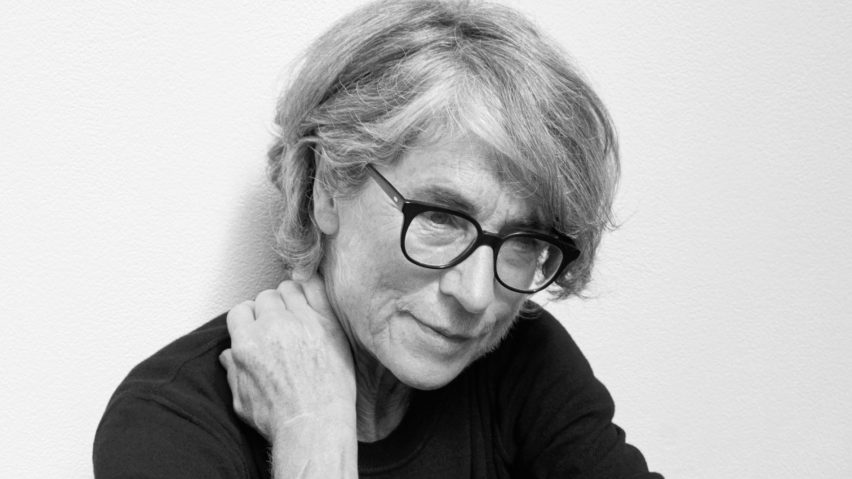Margaret Howell has spent decades as a staple on the London Fashion Week circuit but, in this exclusive interview, she says she is still trying to find her place in the design industry.
Speaking to Dezeen from her studio-cum-store on London's Wigmore Street, Howell said she dislikes the term "fashion designer" and the image it can portray.
"I don't feel I am a fashion designer at all," she said. "I'm rather embarrassed when people describe me as such, because I'm not."
"The public has got such a different view on fashion – it's always the extravagant and the wacky," she continued. "This has its place and is really admirable, but it's not what I do."
After four decades in the industry, the 71-year-old has become known for her simple, utilitarian silhouettes in relatively muted colour palettes. Her garments are often categorised as minimalist, making them a favourite with architects and designers.
Howell is "more interested in making than selling"
One of Howell's unique talents is that she manages to maintain a consistent style – each collection follows seamlessly from the next, unaffected by trends.
She said her enthusiasm lies in the craft of each piece, rather than the spectacle of the show.
"I was always more interested in making than selling," she said. "There were people out there that wanted [a certain] sort of clothes. But I knew I couldn't do something for the sake of it."
"The press didn't affect me," she added. "I do remember once when they really did sort of latch on and I couldn't do anything. But then, of course, they would move away when a new theme came along."
For Paris Fashion Week next month, Howell is preparing to unveil a collaboration with Mourne Textiles, a family-led brand from Northern Ireland that specialises in traditional hand-woven scarves, shawls, blankets and soft furnishings.
She is currently also doing a guest takeover of Tate Edit, the retail concept store at London's Tate Modern, where she has paired her own designs with traditionally made British furniture and artisanal glassware from Japan.
"We were always sewing or embroidering"
The designer attributes her love of handmade designs to her childhood, growing up in Surrey in the 1940s and 50s.
"I've always made things – that was our childhood," she explained. "It was just after the war, so we were always sewing or embroidering."
"My sister was very into art. She started to print scarfs. But then she went off to work to earn money," she continued. "I carried on printing scarves for her, but I really wanted to get my teeth into something more permanent."
Howell went on to study fine art at Goldsmiths University, graduating in 1969, and eventually ended up working in menswear design. The care and detail she put into the tailoring of her shirts soon attracted the attention of high-end retailers, including Browns and Paul Smith.
"It began with mens' shirts and then led on to mens' jackets," she said. "My first jacket was an unlined linen one, like you used to see old men on holiday wearing on the front in Brighton."
"I always had these sort of connections with clothes – they were always a memory of something," she added.
Howell dislikes "brash" architecture
The designer opened her first standalone store in 1977 and expanded into womenswear in 1980. Today she has shops all over the world, including more than 100 in Japan.
She worked with Will Russell of Pentagram to design her Wigmore Street space, which opened in 2002. She is also about to open a new London store at Coal Drops Yard, the new shopping area in King's Cross designed by Thomas Heatherwick.
When it comes to architecture, Howell said she dislikes the "brash" buildings that dominate the UK capital, citing the glass-fronted structures on the Southbank as a particular example.
"I like architects that can actually build something sympathetic to the surroundings, or a well-executed modern conversion in an old setting," she said.
"I suppose that harks back to my own love of traditional things like saddlery and leather goods. I always want to have something of that in the bags I design, but I also want to make it modern and light."
Own home is "very practically designed"
Howell no longer lives in the city – her own home is a Suffolk property designed by Swiss architect Rudy Mock.
Mock made his name designing modern apartments in Switzerland before moving to the US in 1938, where he worked under Louis Kahn and Frank Lloyd Wright. He moved to London in the 1940s, designing a range of student halls and private residences.
Featuring a distinctive salmon-pink exterior, the house forms part of a terrace of six. Howell used to holiday nearby as a child, but only took notice of these properties as she grew older.
"They were built as holiday homes, on a very rural lane leading down to the sea," she said. "They are in a sort of staggered terrace, but they're separated by car parks. They are very practically designed."
Margaret Howell's Tate Edit takeover continues until September, while her new Coal Drops Yard Store is due to open on 26 October.
Portrait of Margaret Howell is by Ellen Nolan.

